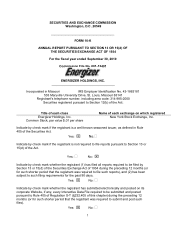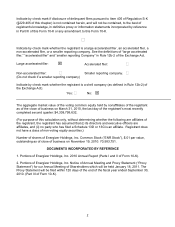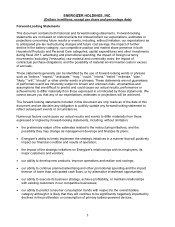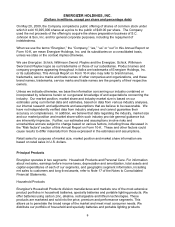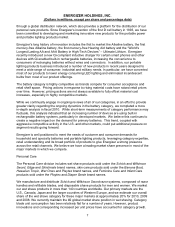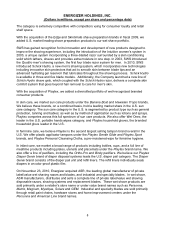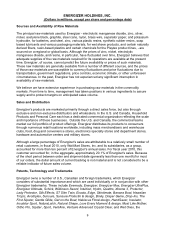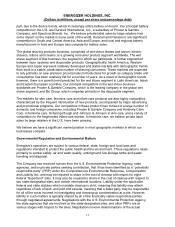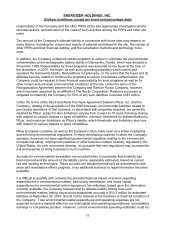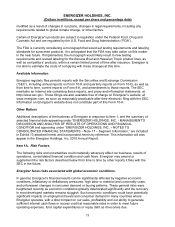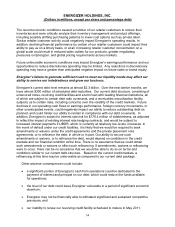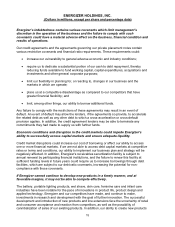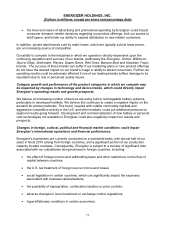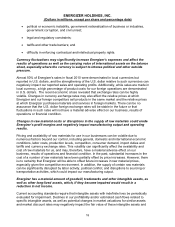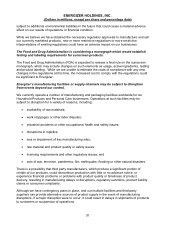Energizer 2010 Annual Report Download - page 21
Download and view the complete annual report
Please find page 21 of the 2010 Energizer annual report below. You can navigate through the pages in the report by either clicking on the pages listed below, or by using the keyword search tool below to find specific information within the annual report.
ENERGIZER HOLDINGS, INC.
(Dollars in millions, except per share and percentage data)
11
part, due to the device trends, which increasingly utilize battery-on-board. Our principal battery
competitors in the U.S. are Duracell International, Inc., a subsidiary of Procter & Gamble
Company, and Spectrum Brands, Inc. We believe private-label sales by large retailers had
some impact on the market in some parts of the world. Duracell and Panasonic are significant
competitors in South and Central America, Asia and Europe, and local and regional battery
manufacturers in Asia and Europe also compete for battery sales.
The global shaving products business, comprised of wet shave blades and razors, electric
shavers, lotions and creams, is a growing consumer product segment worldwide. The wet
shave segment of that business, the segment in which we participate, is further segmented
between razor systems and disposable products. Geographically, North America, Western
Europe and Japan represent relatively developed and stable markets with demographic trends
that result in a stable, predictable number of shaving consumers. These markets are expected
to rely primarily on new premium priced product introductions for growth as category blade unit
consumption has been relatively flat for a number of years. As a result of demographic trends,
however, there is a growth trend predicted for the wet shave segment in Latin American, Asian
and Eastern European countries. Our principal competitors in the wet shave business
worldwide are Procter & Gamble Company, which is the leading company in the global wet
shave segment, and Bic Group, which competes primarily in the disposable segment.
The markets for skin care, feminine care and infant care products are also highly competitive,
characterized by the frequent introduction of new products, accompanied by major advertising
and promotional programs. Our competitors in these product lines consist of a large number of
domestic and foreign companies, including Procter & Gamble Company and Kimberly-Clark
Corp. in feminine care, Schering-Plough and Johnson & Johnson in skin care, and a variety of
competitors in the fragmented infant care market. In feminine care, we believe private label
sales by large retailers in the U.S. have been growing.
We believe we have a significant market position in most geographic markets in which our
businesses compete.
Governmental Regulation and Environmental Matters
Energizer’s operations are subject to various federal, state, foreign and local laws and
regulations intended to protect the public health and the environment. These regulations relate
primarily to worker safety, air and water quality, underground fuel storage tanks and waste
handling and disposal.
The Company has received notices from the U.S. Environmental Protection Agency, state
agencies, and/or private parties seeking contribution, that it has been identified as a “potentially
responsible party” (PRP) under the Comprehensive Environmental Response, Compensation
and Liability Act, and may be required to share in the cost of cleanup with respect to eight
federal “Superfund” sites. It may also be required to share in the cost of cleanup with respect to
two state-designated sites, and certain international locations. Liability under the applicable
federal and state statutes which mandate cleanup is strict, meaning that liability may attach
regardless of lack of fault, and joint and several, meaning that a liable party may be responsible
for all of the costs incurred in investigating and cleaning up contamination at a site. However,
liability in such matters is typically shared by all of the financially viable responsible parties,
through negotiated agreements. Negotiations with the U.S. Environmental Protection Agency,
the state agencies that are involved on the state-designated sites, and other PRPs are at
various stages with respect to the sites. Negotiations involve determinations of the actual


